Prolink Pixelview Ge-Force2 Ti
|
As you can see, Prolink have taken the memory clock of the card slightly over specification from the 400Mhz defined by NVIDIA in the official spec for the GF2 Ti. That's pretty much bang on the 4.5ns rating for DDR memory so we can make an educated guess that the card features memory of that rating. Taking a look at the card itself we can see it's a fairly stock reference design on a yellow/gold PCB with a small, actively cooled gold coloured heatsink and no ramsinks. As you can see the card also features TV-Out next to the standard 9-pin DSUB connector. Quite an attractive little card on its coloured PCB but nothing extravagant. 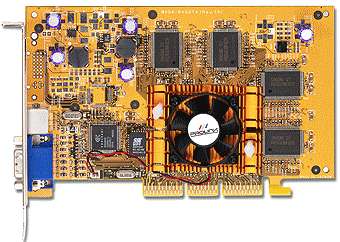 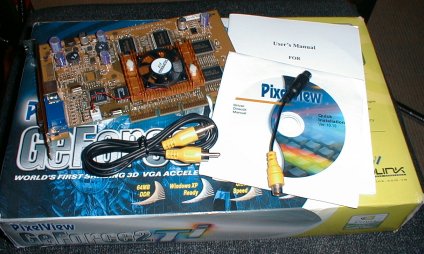 Performance Introduction Test System:
Stock Performance Quake3 has been around for quite a while in various shapes and sizes and its engine is currently powering the smash hit first person shooter, Return To Castle Wolfenstein. It's OpenGL based but doesn't require any advanced features like vertex or pixel shader. Current or past owners of GF2 class hardware will testify towards the performance of GF2 cards when running a Quake3 engined game. 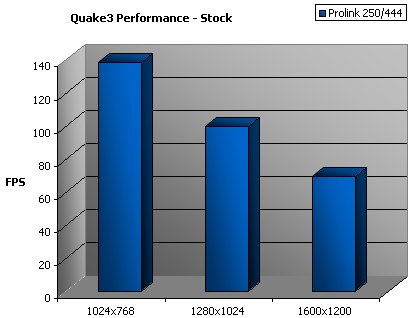 Bear in mind that the Quake3 runs were done with 32-bit colour, 32-bit textures and all high visual quality options enabled or turned to the maximum available setting. Even with every performance eating feature enabled, the card was still able to push out an average of over 60fps at 1600x1200x32 with close on 140fps available at 1024x768, the most common gaming resolution. Quake3 was designed with this card as the ideal render target so it's no surprise that performance is excellent. Unreal Tournament is another game that should perform very well on the test system. Unreal Tournament is more dependant on CPU performance than card throughput to a certain degree. This should show in our benchmarks. It's a DirectX 7 game and doesn't need DX8 features like vertex and pixel shaders.  As you can see the performance difference in changing resolutions isn't huge. I actually sat and played UT for a couple of hours just doing local botmatch practice at 1600x1200 and even with the CPU doing the calculations for 8 bots on decent sized maps, everything remained very playable. Don't let the low figure of just 46.57fps put you off attempting to play at 1600x1200 as long as you have the CPU power to back it up. It was very playable on the test setup. Aquamark is the first of our benchmarks that require DX8 rendering features to be present on the graphics card to perform well. Based on Aquamark, it's very heavily reliant on pixel and vertex shader programs within the renderer to offer optimal performance. If it can't use those hardware accelerated features it has to pass the calculations to the host CPU which is significantly slower than doing it onchip on the GPU.
Finally in this look at stock performance we have 3DMark 2001. Being another program that enjoys running on hardware that implement the pixel and vertex shader in hardware, we shouldn't expect stellar performance from the GeForce2 Titanium. It's a stock benchmark (3DMark was loaded and the Benchmark button was pressed, simple) and the driver wasn't tweaked in any way. Ideally when talking about 3DMark, a score of 6000 or more indicates acceptable performance. To achieve this on a GF2 card you need big card clocks and a lot of CPU horsepower behind it.  While we are well short of 6000 marks we are 200 clear of the Sparkle we recently reviewed on the same host platform. The extra memory clock helps here to find the extra speed. The lack of hardware accelerated DX8 features cripples the card somewhat in this benchmark. We could argue however that even many months after DirectX8's release, games targeting the feature set aren't exactly thick on the ground. You can't deny that DX8 performance is low on the GF2 however. So how is out of the box performance? On pre DX8 class games the card is perfect. It runs older stuff very well. You'd expect this from a card more than 18 months old and with NVIDIA solid drivers behind it. On the test platform, DX8 performance is adequate. Nothing special but quite playable. Aquamark was heavy on the card however. Overclocked Performance After seeing the clock speeds that a few friends have gleaned from their Gainward GF2 Ti450's using the same GPU, I had high hopes for the Prolink. The Gainward doesn't have ramsinks either so things are fairly equal on the cooling side of things. However the Prolink didn't want to go very high in terms of memory or core clock. Maybe Gainward are actively snapping up the best cores and memory chips for their Golden Sample cards but either way, the maximum clock of our test card was 266/466. Just 16/22Mhz over the stock clocks isn't that great however the ram isn't actively or even passively cooled and the heatsink on the card is nothing special. Quake3 first. 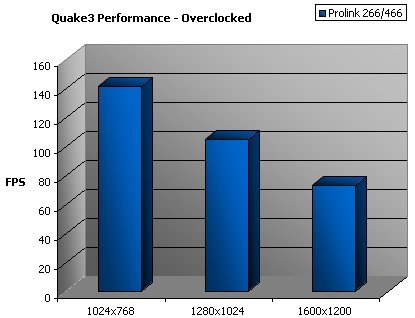 Only a few frames over the stock clocked results but an increases all the same. Performance was high already from the card. Unreal Tournament next. 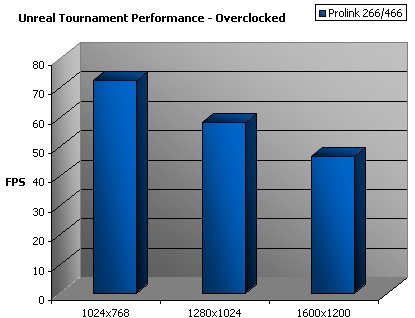 We see 3fps increase for the lower resolutions and only ~1fps difference at 1600x1200. UT is sensitive to CPU more than card clocks hence the modest increases for the new clocks used. Again, very playable even at the top resolution. It's just a shame that the card can't clock a bit higher.
 Only 130 marks increase for our new card clocks. Not earth shattering but essentially the performance is free so we can't complain. However it would have been nice to see some better cooling on the card to achieve higher clocks. Maybe Prolink can borrow a few of Gainwards seemingly Herculean cores for the next round of cards! It turns out the gains to be made are in Quake3 and 3DMark. UT and Aquamark being CPU influenced for different reasons didn't respond well to the extra clocks unfortunately. If you are looking for higher clocks we suggest replacing the GPU cooler with something like a Crystal Orb and fragtaping some ramsinks onto the ram chips. You should see a few more Mhz for your money with better cooling to unlock that final facet of free performance. Conclusion For the price these little GeForce2 Ti's are hard to resist if you have a low budget to stick to or you are conscienciously using the card as a stepping stone to a new card, maybe skipping a generation of GPU or waiting for prices to fall on a currently expensive card. The card competes in a fairly crowded arena with the other GeForce2 Ti cards and also ATi's Radeon 7500, a card we recently reviewed and found to be excellent for the price. All these cards are around £100-£120 in price and most feature TV-Out and in the case of the Radeon, dual head capability and class leading DVD playback. The only drawback is that it overclocks poorly, at least this test card does. Otherwise, if the price is good for you, the performance certainly should be given a decent platform behind it. Good job Prolink and hopefully they can increase their exposure in the UK in the coming year since the PixelView GeForce2 Ti is a nice little card. Recommended for the budget buyer and canny upgraders. |

















